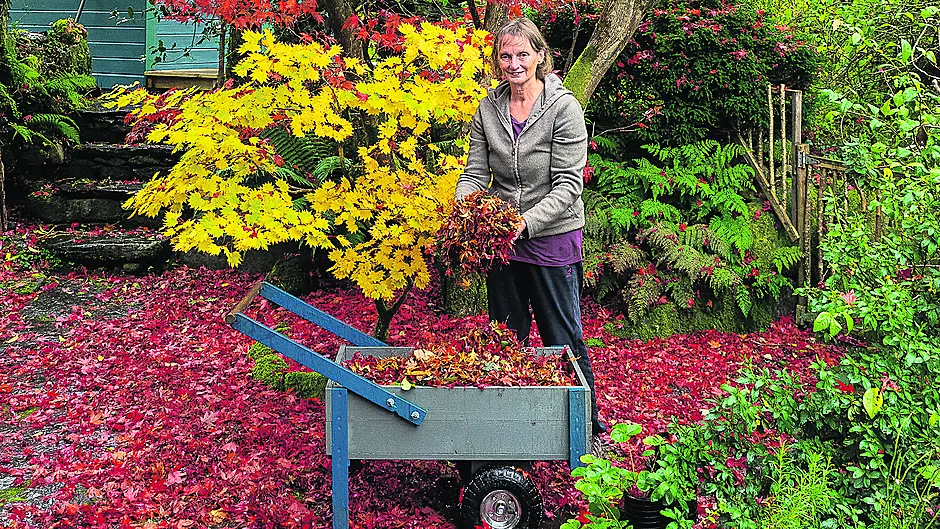By Joyce Russell
It’s time to put the garden to bed for the winter. Think about digging beds over, digging in some manure and covering the surface with something to shed water. You can reuse black polythene for many years if you want a long lasting cover – weight the edges down well so the cover stays where you want it. Simply remove this in the spring and the soil underneath will be all ready for planting. A straw mulch helps protect the crowns of vulnerable plants in the herbaceous border.
Think about protecting taps and pipe joints that may freeze in cold weather. Fix latches so greenhouse windows and doors don’t bang in a wind and check the shed roof isn’t letting in water. Bring all tools indoors and clean the mower before storing for the winter.
Lots of leaves
Some trees have already lost all their leaves and others are only just starting the process. Strong winds will scatter leaves far and wide, but in calm weather you will get a lovely drift of colour on the ground. This can look beautiful, but don’t let leaves lie too long before gathering them up and putting them to good use in the garden.
If leaves fall on the lawn, then simply mow them up and use the mix of leaf and grass clippings to cover empty beds. If the bed has been dug over, this mulch will provide some protection from rain. Some dry leaves may blow off the bed, but wet ones tend to stay where you put them.
Use a rake on paved areas and scoop leaves into a barrow. You can add a thin layer to the compost heap or use the lot to make leaf-mould.
Winter lettuce
Plants are growing well from a late August sowing and there are plenty of leaves to use. Take one or two from each plant and more will keep on growing. Winter salad does best in a greenhouse or polytunnel or under a cloche or cold-frame in the outdoor garden. Keep some ventilation flowing if you want to avoid problems with moulds and mildews.
Check for slugs and snails hiding under lower leaves and remove any you find. These pests reduce activity through the colder months, but in a mild autumn, and in a covered space, they can be active for longer than you imagine. It can be surprisingly easy to find there is a single culprit if you go out to the greenhouse after dark with a torch. Replace any badly damaged plants with new ones if you have any left over, these may be small compared to the rest of the row, but they will help stretch out the cropping season.
You can make a last sowing of winter lettuce now, for growing on in a polytunnel or greenhouse. Sow in pots and cover with bubble wrap until the seedlings emerge. Plant into the ground when big enough – plants will grow slowly and will look small until they put on a spurt in the New Year. You will have plenty of spring salad leaves from this sowing.
Time to sow peas
If you are sowing outdoors then you need to use an autumn sowing variety like Douce Provence, First Early May, or Meteor.
If you are growing the plants in a polytunnel or greenhouse, then you can stretch the range and try a summer variety if that’s all you have got. I grew Hurst Greenshaft through last winter in my polytunnel and got a terrific crop of peas in the spring.
Mangetout peas are a good option for growing under cover through the winter. They crop earlier and clear a little faster than podding varieties. I like to start seed in pots – in fact I use fruit punnets and sow around eight seeds per tub. These are easy to plant out when the seedlings are big enough – simply tip out the intact contents of a tub and firm this into the ground. Sow 10-12 punnets to be sure of having enough for a row.
Think about broad beans
You can sow autumn varieties over the next week or so. These work well sown directly into the ground, but cover the row with a polythene cloche if growing outdoors. This helps avoid seed rotting in cold wet soil, before it has a chance to germinate.
Sowings in the polytunnel can also benefit from an extra covering in cold weather. Use a woven or fleece cover that allows some air to pass through – seedlings can be prone to moulds if growing in a poorly ventilated space. Remove the cover when plants are 6in tall. It’s worth sowing a few extra seeds in pots to replace any that fail in the row. And allow a little extra space, maybe 8-9in between seeds, so plants aren’t crowded when growing.










